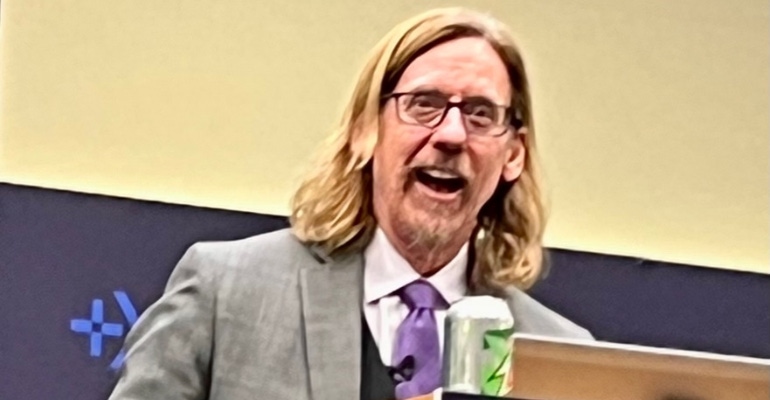Mayo Clinic’s top engineer shows us how healthcare is changing before our eyes – and why it matters.
November 9, 2022

Talking about disruptive technology and the future of healthcare requires a certain kind of energy. Maybe that energy was found in the can of Diet Mountain Dew that Mark Wehde carried to the podium, or maybe it was just his unique brand of energy. Whatever the source, the chair of engineering at Mayo Clinic certainly brought the required energy to the Engineering Theater stage at MD&M Minneapolis and left the standing-room-only crowd satisfied, yet somehow still thirsting to hear more.
Mayo Clinic has a rich history dating back to the 1800s in Rochester, MN. And yet, even May is not immune to changes in the healthcare ecosystem.
“Healthcare has now reached a point where it is ripe for disruption,” Wehde said. “It’s heavy, it’s bloated, it’s expensive, and medical errors are the third leading cause of death.”
Wehde said it is becoming increasingly clear that the move to providing lower cost care for patients at home is the right approach, especially in the wake of the COVID-19 pandemic.
“So, what’s meant when we talk about the home hospital and the hospital of the future? How do we monitor our health using home and wearable devices? And how do we make healthcare accessible to the billions of marginalized people in the world? I think we can turn to science and technology to help answer some of those questions," Wehde said.
Healthcare is not going to look the same in 10 years as it does today, and Wehde used driverless cars as an analogy for how healthcare is changing and why it needs to.
"In big cities, traffic’s a mess. People speed up and slow down at the wrong times and it creates these waves of disruption in the flow of traffic," Wehde said. "Healthcare today looks like this. It’s a complicated system with unnecessary duplication, long waits, disorganized knowledge, and most importantly, it’s designed for episodic care whereas most conditions are chronic."
Looking at the traffic example, putting a GPS and drive-by-wire technology in every vehicle has the potential to create perfect spacing and speed up the flow of traffic dramatically, according to Wehde, and healthcare is much the same, he said.
"The hospital of the future is going to be in your home, it’s going to be in your community, and only serious conditions are going to require a hospital stay," Wehde said.
That means major healthcare systems will need to rethink their plans.
"Expansion no longer means more hospital beds or more brick and mortar facilities," he said. "It means providing care wherever the patient is. Providing care based on continuous relationships. It means providing care whenever and wherever it’s needed."
To get there, the ability to leverage data in meaningful ways will be key. Wehde said Mayo is making a huge commitment to AI and machine learning, data management, data science, and cloud data management.
"This is what drove our partnership with Google … you’d be amazed at the number of people we’ve hired in over the last three to four years to be working on this digital transformation in healthcare," Wehde said.
Because of its rich history, and the fact that Mayo had the foresight to create an electronic medical record system back in the 1990s, Mayo is poised to create the largest, deepest, and most informative collection of biomedical data in the world, Wehde said.
“We’re going to have longitudinal data sets, data across time, that’s going to allow us to integrate medical data, financial data, and data from home and self-monitoring sources, and we’re going to be able to do that over a patient’s entire life, and we’ll be able to apply advanced analytics and AI to generate new insights for these patients and their care givers," he said.
Mayo is also looking at a continuum of care model, Wehde said, where patients may start at a major healthcare center for a serious illness before being transferred back into their community care facilities, and eventually into their homes.
Mayo Clinic engineers and experts like Wehde are also looking at ways to develop real-time refinement of individualized care solutions.
"We’re going to have data from home monitoring sources so we can make changes on the fly, and I think the explosion of consumer wearable devices that we’ve seen over the last decade is going to morph into wearable medical devices over the next decade," he said.
And of course, the goal – and the expectation, Wehde said – is to be able to monitor, diagnose, and treat patients anywhere, anytime.
About the Author(s)
You May Also Like




